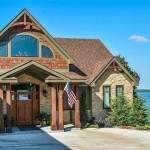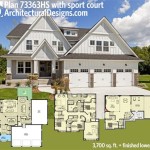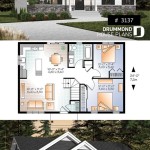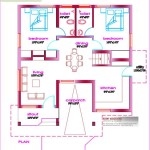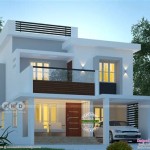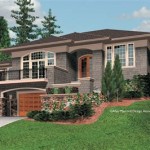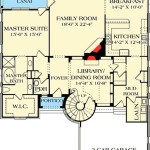House Plans With In-Law Suite Above Garage: A Comprehensive Guide
The integration of an in-law suite above the garage is an increasingly popular architectural trend, addressing the needs of multi-generational families, providing rental income opportunities, or offering a private space for guests. These house plans require careful consideration to ensure functionality, privacy, and adherence to building codes. This article explores key aspects of these designs, highlighting important considerations for potential homeowners.
In essence, a house plan with an in-law suite above the garage involves creating a self-contained living area, complete with a bedroom, bathroom, living space, and often a kitchenette, situated directly above the garage structure. This configuration maximizes the use of available land, offering a separate living space while minimizing the overall footprint of the house. The arrangement provides a degree of privacy for both the main residence and the in-law suite, which is a critical factor for harmonious cohabitation.
The appeal of these house plans stems from their versatility. They can accommodate aging parents, adult children returning home, long-term guests, or even renters, providing a separate living space without requiring a significant expansion of the main house or the construction of a separate detached unit. This type of design is especially beneficial in areas with high land costs, where building outwards may be prohibitively expensive. Carefully planned access, soundproofing, and utilities are crucial to a successful outcome.
Key Point 1: Design Considerations and Structural Integrity
Planning a house with an in-law suite above the garage involves careful consideration of several design elements to ensure both structural integrity and functionality. The garage structure must be able to support the weight of the suite, including the occupants, furniture, and building materials. This often necessitates reinforcing the garage foundation and support beams. Architects and structural engineers will conduct thorough assessments to determine the existing load-bearing capacity of the garage, or design a new garage with the necessary specifications.
Accessibility is a primary consideration. How will residents of the in-law suite access their living space? Options include an exterior staircase leading directly to the suite, an interior staircase accessible through the main house (though this can compromise privacy), or even an elevator in certain situations. The choice of access point will influence the overall design and layout of both the garage and the in-law suite.
Privacy between the main house and the in-law suite is paramount. Soundproofing measures, such as insulated walls and floors, resilient channels, and solid-core doors, are essential to minimize noise transmission. Furthermore, the placement of windows and doors should be carefully considered to avoid direct lines of sight between the two living spaces. The specific needs of the intended occupants will dictate the level of privacy required.
Climate control should be addressed independently for the in-law suite. This can be achieved through a separate HVAC system or, in some cases, a zone-controlled system that allows for individual temperature adjustments. Efficient insulation is crucial to minimize energy consumption and maintain comfortable living conditions. Consideration should be given to the orientation of the house to maximize natural light and minimize solar heat gain, further contributing to energy efficiency.
The layout of the in-law suite itself should maximize functionality and comfort within the available space. A well-designed kitchenette with essential appliances, a comfortable living area, a private bedroom, and a bathroom are all necessary components. Storage space is also a critical consideration, as a lack of storage can lead to clutter and discomfort. Built-in storage solutions, such as shelves and cabinets, can help maximize space efficiency.
Key Point 2: Legal and Regulatory Compliance
Before embarking on the construction of a house with an in-law suite above the garage, it is essential to investigate local zoning regulations and building codes. Many municipalities have specific requirements regarding accessory dwelling units (ADUs), which often encompass in-law suites. These regulations may dictate minimum and maximum size restrictions, setback requirements, parking requirements, and occupancy limitations.
Zoning regulations can vary significantly from one jurisdiction to another. Some municipalities may prohibit ADUs altogether, while others may have strict regulations governing their design and use. It is crucial to consult with the local planning department or a qualified land use attorney to understand the applicable zoning regulations and ensure that the proposed construction is compliant. Failure to comply with zoning regulations can result in fines, legal action, and even the forced removal of the in-law suite.
Building codes also play a critical role in ensuring the safety and structural integrity of the construction. Permits are typically required for any construction or renovation work that involves structural changes, electrical wiring, plumbing, or HVAC systems. Building inspections are conducted throughout the construction process to ensure compliance with the applicable building codes.
Fire safety is a particularly important consideration when designing an in-law suite above the garage. Building codes typically require fire-rated walls and ceilings between the garage and the in-law suite to prevent the spread of fire. Smoke detectors and carbon monoxide detectors are also required in both the garage and the in-law suite. An escape route, such as a fire-rated staircase or an emergency exit window, must be provided for the occupants of the in-law suite.
Accessibility requirements, as outlined in the Americans with Disabilities Act (ADA) and local accessibility codes, may apply to in-law suites, particularly if they are intended for use by individuals with disabilities. These requirements may include ramps, wider doorways, accessible bathrooms, and other features that facilitate accessibility and usability.
Key Point 3: Cost Considerations and Return on Investment
The cost of building a house with an in-law suite above the garage can vary significantly depending on the size, complexity, and features of the suite. Construction costs typically include materials, labor, permits, and professional fees (architect, engineer, contractor). It is essential to obtain multiple bids from qualified contractors and to carefully review the scope of work and cost estimates before selecting a contractor.
Reinforcing the garage structure to support the weight of the in-law suite is a significant cost factor. This may involve strengthening the foundation, adding support beams, and upgrading the roofing system. The cost of these structural modifications will depend on the existing condition of the garage and the specific design of the in-law suite.
The cost of utilities, such as plumbing, electrical wiring, and HVAC systems, can also add significantly to the overall cost. Installing separate utility meters for the in-law suite can allow for independent monitoring and billing of utility consumption, simplifying financial management. However, this can also add to the upfront cost of construction.
Financing options for building a house with an in-law suite above the garage may include construction loans, home equity loans, or refinancing existing mortgages. It is important to shop around for the best interest rates and loan terms. The potential for rental income from the in-law suite can be factored into the loan application, potentially increasing the borrowing capacity.
The return on investment (ROI) for a house with an in-law suite above the garage can be significant. The suite can provide rental income, which can help offset mortgage payments and other expenses. It can also increase the resale value of the property, making it more attractive to potential buyers seeking multi-generational living options. The financial benefits of having an in-law suite should be carefully weighed against the cost of construction to determine the overall feasibility of the project.
Beyond financial considerations, the intangible benefits of having an in-law suite should also be taken into account. The suite can provide a safe and comfortable living space for aging parents, allowing them to remain close to family while maintaining their independence. It can also offer a private space for adult children returning home, making the transition back to living with parents easier. The convenience and flexibility of having an in-law suite can significantly enhance the quality of life for all members of the household.

An Over Garage In Law Suite With A Wealth Of Storage Fine Homebuilding Studio Apartment Floor Plans

Homes With Mother In Law Suites

Mother In Law Suite Garage Apartment Plans Floor

Mother In Law Apartment Plan House Plans
Chic And Versatile Garage Apartment Plans Blog Eplans Com

Mother In Law Suite Floor Plans Garage Apartment

Small 2 Story House Floor Plan With Car Garage

Modern Farmhouse Plan With In Law Suite 70607mk Architectural Designs House Plans

Chic And Versatile Garage Apartment Plans Blog Eplans Com

5 Bedroom Ranch House Plan With In Law Suite 2875 Sq Ft

